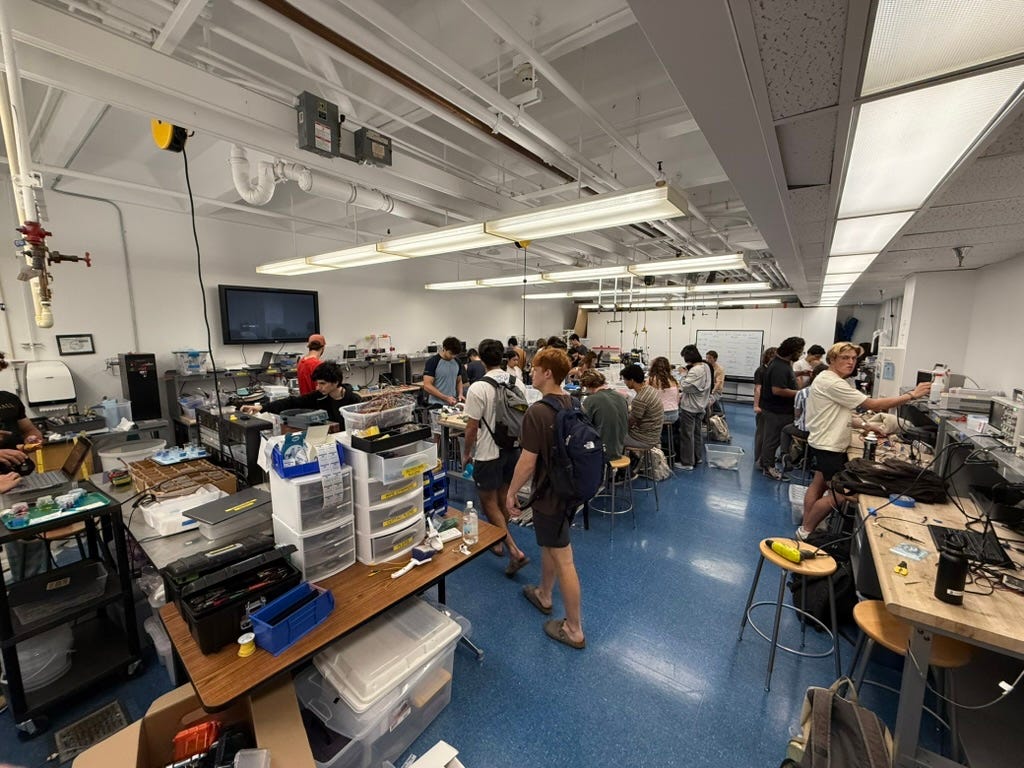Thank you for being here. As always, these essays are free and publicly available without a paywall. If my writing is valuable to you, please share it with a friend or support me with a paid subscription.
Living on top of a hill in Connecticut made for some interesting winter driving experiences. Most of the time, it was no problem, as long as you were following the plows. But if you got there before them, you were in for an adventure.
I remember sitting in the car, pulse slightly elevated, ready to see if we would make it up. Four-wheel drive would have been nice, but here we were in the minivan with only front-wheel drive to work with. We’d stop momentarily at the penultimate hill, checking to see that no one was coming and prepping to take a run at scooting up the big one.
When it was especially icy, the only way to reliably get up the hill was to get a moving start. You had to shoot down one hill with an eye on the three-way junction to (a) make sure that no one was coming from the left trying to pull a similar move and (b) check that no one was sliding down the hill. You wanted to make sure you had use of both your lane and theirs on your way up.
Take a deep breath, and here we go. Goosing the accelerator, you tried to pick up as much speed as you could going down the hill without overplaying your hand and spinning out. Think real-life, jumbo skeeball without the ramp at the end (at least you hoped the curb wouldn’t become one for you). If you were lucky enough to pick up enough momentum, you’d be able to slide up and over the hill, grabbing enough traction from a thin layer of snow and the icy road that lay beneath it. But if you didn't get enough momentum coming down the small hill or tried to accelerate too quickly up the hill, your wheels would just spin and spin. Back down to give it another shot. Although I don't remember too many failed attempts, there were a few tricky approaches.
Not all friction is created equal
After living in Southern California for over a decade, it’s been a while since I’ve driven on icy roads, but I still haven’t forgotten the feeling. It’s not exactly fun, driving on ice. But one thing is for sure: it teaches you to be grateful for friction.
We seem to have lost this more holistic understanding of friction in many dimensions of our life and work. This is especially true when it comes to our technology.
There are good reasons why friction gets a bad rap. In a mechanical system, friction is often wasted energy. In business, if you have too many hoops for users to jump through to create an account, place an order, or submit an inquiry, you'll lose them. This sort of friction is bad for business and worth reducing or eliminating altogether.
But this is not the only kind of friction. There's another kind of friction, the kind that you want when you're trying to drive your car up an icy hill. This is the friction that gives you traction. In this situation and in many others—especially in education—friction is essential. No friction, no traction. No traction, no learning.
Rather than ruthlessly eliminating friction, we had better first ask what kind of friction we are eliminating. Is it the parasitic friction that is purely a loss to our system? Or is it the friction that contributes to traction?
To technology, friction is friction
There are plenty of ways that technology can help to eliminate friction. But the tool itself can't discern the difference between productive and parasitic friction. That is a judgment call we must make.
Listen, there’s plenty of parasitic friction to be found and removed. Let's take my favorite example: scheduling meetings. Coordinating schedules is a pain. Ye olden way is to start an email thread with everyone sharing their availability. By the time the last stragglers have shared some open windows, many of the slots that were available from the early respondents are now filled. It's a mess.
Luckily, much of this friction is solved by technology. Setting up a scheduling link that is connected to your calendar is now nearly drop-dead simple. No more back-and-forth emails1. Need to coordinate a group? No problem, we’ve got tools for that too. What used to be a bunch of back-and-forth emails is now a streamlined process. That's the kind of friction elimination I'm all for.
There are also fruitful ways to add AI to this mix. One AI-powered tool that I've grown fond of recently is reclaim.ai. This tool helps to manage my schedule and flexibly block catch-up blocks and lunch breaks. It is built to recognize my human limitations. It can parse my schedule to see when I have a meeting and give me a buffer at the end to switch gears, schedule time at the beginning of the day to catch up, and time at the end of the day to shut down. Even better, it can keep these blocks free and move them around when my calendar is not packed, but once it starts to fill up with other bookings, it locks down the slots to make sure I hold time for my lunchtime. It's pretty great.
This is all well and good. This is the power of technology when used thoughtfully and applied to a narrow domain. Perhaps there’s an LLM or some natural language processing in the background, but it is used for a specific purpose. This is a sign of the real power of AI. It’s not superintelligence. It’s that it offers us a way to tackle some of these more complex, fuzzier tasks in a way that would be tedious and impractical, if not impossible, with less sophisticated algorithms.
But the efficiency optimization of technology cares not whether you point it at friction that is parasitic or productive. For every application of technology that eliminates parasitic friction, there are ten tools that erase productive and parasitic friction without discriminating between them. Don’t have the expertise needed to complete a certain task? No problem, the LLM will take a shot at helping you complete the task without it.
What makes generative AI unique is not so much what it can do, but that it will always give you an answer. The next token can always be predicted, regardless of whether it is accurate or not.
Intelligence and wisdom are not the same thing
This is why the language we use to talk about AI matters. The people building these tools have described them with words like “think” and “reason,” and talk about LLMs being “intelligent” or “smart” without really describing what that means. They’re just playing on the vibes. In a world where the only way to generate a coherent output is to have gone through a process of thinking and reasoning, the output is a reasonable proxy. But LLMs broke that heuristic.
Instead of trying to grapple with this fuzzy definition, I’m with
and who argue that we should think of AI as “normal technology.”The normal technology frame is about the relationship between technology and society. It rejects technological determinism, especially the notion of AI itself as an agent in determining its future. It is guided by lessons from past technological revolutions, such as the slow and uncertain nature of technology adoption and diffusion. It also emphasizes continuity between the past and the future trajectory of AI in terms of societal impact and the role of institutions in shaping this trajectory.
AI as normal technology helps us to have a more grounded conversation and to see the opportunities where AI—like any other technology—can be used to wisely eliminate parastic friction. We need not and should not blindly accept the power of AI applied to any and all problems. It seems likely that AI will be the most powerful technology of our lifetime. But whatever power it may have is our responsibility to wisely steward.
Intelligent? Perhaps, depending on your definition.
Wise? Certainly not.
As you think about the sources of friction in your own life (and especially in your own education), think twice about whether you really want to try and point AI at the problem. In some situations, the friction is purely parasitic. But most of the time, there's something valuable that we risk losing if we're not thoughtful.
Got a thought? Leave a comment below.
Reading Recommendations
over at writes a beautiful, personal reflection on how he is grappling with his own search for solace in the midst of the craziness around us. The search for answers starts with big questions. is wrestling with the same stuff that I am these days. In his recent series of posts, he’s grappling with the concept of Artificial General Intelligence (AGI) and why it’s worth moving beyond the endless debates about whether it’s here yet. It’s fun to trace the threads in parallel and be part of a conversation across time and space.Instead of treating AGI as something up for debate or assuming it (whatever it is) will happen one day, we should collectively giggle at the idea that a machine that applies probabilistic mathematics to giant cultural datasets can only be explained using the terminology of human cognition. As Cosma Shalizi pointed out, attention, as it is used in that famous paper, does not mean what you think it means. “Calling this "attention" [is] at best a joke. Actual human attention is selective.”1

Last week, I stumbled on this post by
about the equality and equity meme of the kids standing on boxes to watch a baseball game. I appreciated the nuanced discussion about what we mean when we say equity and equality, and what philosophy has to say about it.Unfortunately for us, this little picture with the boxes represents the undoing of practically everything we have been trying to achieve in our debates over equality and social justice for the past half-century. (More evidence that when reason goes up against social media, reason loses every time.) Indeed, it is not an exaggeration to say that the inadequacy of the conception of “equity” presented in this picture served as the point of departure of the major debates over egalitarianism that have been central to the discipline since the 1970s.
I linked it above, but will link it here again. Exciting news from
and about their new book in the works, which was announced by planting a flag in the sand that AI is normal technology.The Book Nook
I’m continuing to work my way through Filterworld by
and very much enjoying it. Great insights on how the algorithmificiation of everything shapes how we think and act.The Professor Is In
The lab is packed, and students are getting prepped for their final E80 deployment at Dana Point this weekend. Excited to see how everything comes together as they work on the finishing touches.
Leisure Line



More pizza this weekend. Nothing quite like making it yourself.
Still Life



More Randy’s this weekend, including the special Easter peep donut. Then to Descanso Gardens, where they’ve got a mini Randy’s wooden replica at the railroad.








Yes, technology has done a masterful job of eliminating so many of the frictions we used to be forced to grapple with in everyday life. One such area is customer service. Yes, it can be very uncomfortable and inconvenient to have to deal with customer service people (and many others as well). However, it is in those moments of discomfort and inconvenience that we're forced to grow as people. So by eliminating those situations, technology has also precluded us from growing, and as a result, we're more intolerant, less empathetic, and more fragile than we used to be.
I wondered if you'd be as into the "normal technology" framing as I am. What a well-timed paper and concept!